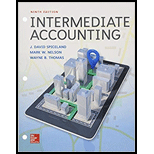
(1)
Ratio Analysis:
Ratio analysis is a tool to analyze the financial statements of a company which expresses a mathematical relationship among the items of financial statements.
To determine: The
(1)
Explanation of Solution
Current ratio:
Current ratio is a
Determine total current assets:
Determine total current liabilities:
Given,
The current ratio of HB Co. is 2.25.
(2)
The acid test ratio
(2)
Explanation of Solution
Acid - Test ratio:
Acid - test ratio or Quick ratio is a liquidity ratio, which displays how current liabilities are paid by the current assets excluding prepaid expenses and inventories. Acid - test ratio is used to measure the company’s immediate short term liquidity. Current assets include cash and cash equivalents, marketable securities and short term investments. Acid-test ratio can be calculated using the formula:
Determine total quick assets:
Determine total current liabilities:
Given,
The acid-test ratio of HB Co. is 1.375.
(3)
Debt equity ratio:
Debt equity ratio is a long term solvency ratio, which expresses the relationship between own funds (shareholders’ equity) and loan funds (debt). This ratio shows the proportion of debts and shareholders’ equity to finance assets. It is calculated by dividing the total liabilities by total shareholders’ equity.
To determine: The debt equity ratio
(3)
Explanation of Solution
Determine total liabilities:
Determine total shareholders’ equity:
The debt equity ratio of HB Co. is 0.65.
(4)
Times interest earned ratio:
Times interest earned ratio indicates the relationship between earnings before interest and tax (EBIT) and interest expense. The purpose of the ratio is to know the payment of interest expense with respect to the company’s earnings.
To determine: The times interest earned ratio.
(4)
Explanation of Solution
The times interest earned ratio of HB Co. is 7.5 times.
Want to see more full solutions like this?
Chapter 3 Solutions
INTERMEDIATE ACCOUNTING(LL)-W/CONNECT
- Parkview Industries collected $275,000 from customers in 2018. Of the amount collected, $135,000 was from services performed in 2017. In addition, Parkview performed services worth $192,000 in 2018, which will not be collected until 2019. Parkview Industries also paid $218,000 for expenses in 2018. Of the amount paid, $168,000 was for expenses incurred on account in 2017. In addition, Parkview incurred $187,000 of expenses in 2018, which will not be paid until 2019. Compute 2018 cash-basis net income. Helparrow_forwardGive correct answer without use of aiarrow_forwardKindly help me with this General accounting questions not use chart gpt please fast given solutionarrow_forward
- i want to this question answer the genral accounting question with 100% correct solution do fastarrow_forwardI need help finding the accurate solution to this financial accounting problem with valid methods.arrow_forwardCan you explain the correct approach to solve this general accounting question?arrow_forward

 AccountingAccountingISBN:9781337272094Author:WARREN, Carl S., Reeve, James M., Duchac, Jonathan E.Publisher:Cengage Learning,
AccountingAccountingISBN:9781337272094Author:WARREN, Carl S., Reeve, James M., Duchac, Jonathan E.Publisher:Cengage Learning, Accounting Information SystemsAccountingISBN:9781337619202Author:Hall, James A.Publisher:Cengage Learning,
Accounting Information SystemsAccountingISBN:9781337619202Author:Hall, James A.Publisher:Cengage Learning, Horngren's Cost Accounting: A Managerial Emphasis...AccountingISBN:9780134475585Author:Srikant M. Datar, Madhav V. RajanPublisher:PEARSON
Horngren's Cost Accounting: A Managerial Emphasis...AccountingISBN:9780134475585Author:Srikant M. Datar, Madhav V. RajanPublisher:PEARSON Intermediate AccountingAccountingISBN:9781259722660Author:J. David Spiceland, Mark W. Nelson, Wayne M ThomasPublisher:McGraw-Hill Education
Intermediate AccountingAccountingISBN:9781259722660Author:J. David Spiceland, Mark W. Nelson, Wayne M ThomasPublisher:McGraw-Hill Education Financial and Managerial AccountingAccountingISBN:9781259726705Author:John J Wild, Ken W. Shaw, Barbara Chiappetta Fundamental Accounting PrinciplesPublisher:McGraw-Hill Education
Financial and Managerial AccountingAccountingISBN:9781259726705Author:John J Wild, Ken W. Shaw, Barbara Chiappetta Fundamental Accounting PrinciplesPublisher:McGraw-Hill Education





